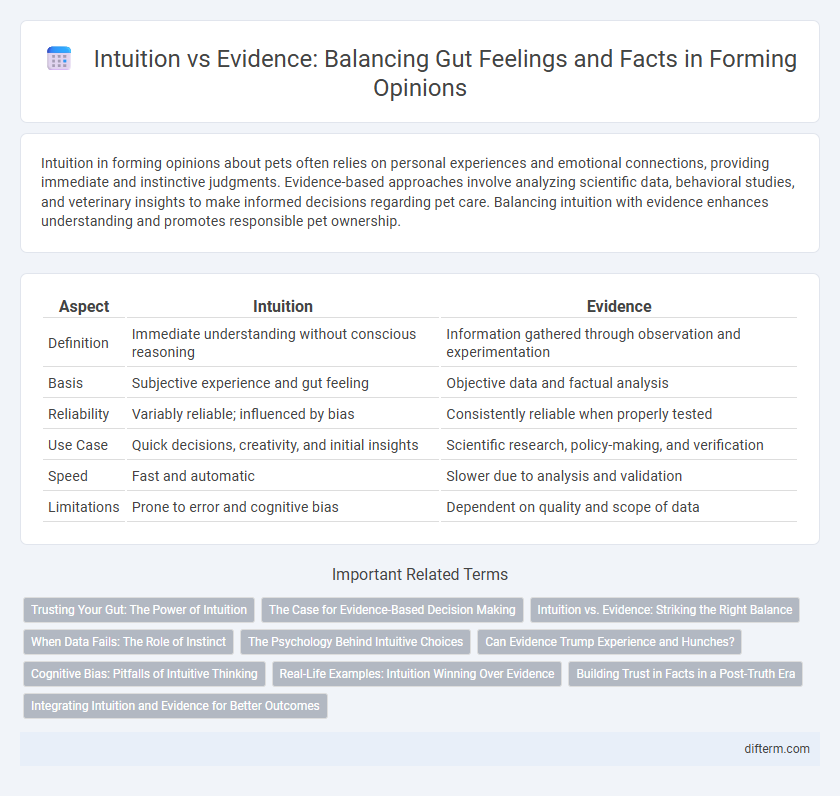Intuition in forming opinions about pets often relies on personal experiences and emotional connections, providing immediate and instinctive judgments. Evidence-based approaches involve analyzing scientific data, behavioral studies, and veterinary insights to make informed decisions regarding pet care. Balancing intuition with evidence enhances understanding and promotes responsible pet ownership.
Table of Comparison
| Aspect | Intuition | Evidence |
|---|---|---|
| Definition | Immediate understanding without conscious reasoning | Information gathered through observation and experimentation |
| Basis | Subjective experience and gut feeling | Objective data and factual analysis |
| Reliability | Variably reliable; influenced by bias | Consistently reliable when properly tested |
| Use Case | Quick decisions, creativity, and initial insights | Scientific research, policy-making, and verification |
| Speed | Fast and automatic | Slower due to analysis and validation |
| Limitations | Prone to error and cognitive bias | Dependent on quality and scope of data |
Trusting Your Gut: The Power of Intuition
Trusting your gut taps into deep-seated cognitive processes that bypass analytical reasoning, offering rapid and often accurate judgments shaped by experience. Neuroscientific research highlights that intuition activates the brain's limbic system, responsible for emotional and subconscious evaluations, enabling decision-making in complex or uncertain situations. While evidence provides objective validation, intuition remains a powerful tool for generating insights when data is incomplete or time is limited.
The Case for Evidence-Based Decision Making
Evidence-based decision making ensures more reliable outcomes by grounding choices in verified data and empirical research rather than subjective intuition. Studies show that organizations guided by evidence often experience higher success rates and reduced risks compared to those relying solely on gut feelings. Integrating quantitative metrics and qualitative insights fosters balanced, informed decisions that align with measurable goals and long-term strategy.
Intuition vs. Evidence: Striking the Right Balance
Intuition offers rapid insights rooted in experience, often guiding decisions when evidence is incomplete or ambiguous. However, relying solely on intuition can lead to biases and errors, making evidence-based analysis crucial for validating or challenging gut feelings. Striking the right balance involves integrating intuitive judgments with empirical data to enhance decision-making accuracy and adaptability.
When Data Fails: The Role of Instinct
When data fails, instinct serves as a crucial guide in decision-making, especially under uncertain conditions where empirical evidence is incomplete or ambiguous. Intuition draws on subconscious pattern recognition and past experiences, enabling quick, adaptive responses that raw data may overlook. In fields like medicine and crisis management, relying on instinct alongside evidence can improve outcomes when time-sensitive judgments are necessary.
The Psychology Behind Intuitive Choices
Intuitive choices stem from the brain's ability to rapidly process subconscious patterns and experiences, often bypassing deliberate analytical thought. Psychological research indicates that intuition activates the brain's emotional centers and memory networks, enabling swift decision-making when evidence is incomplete or time-constrained. While evidence-based reasoning relies on systematic evaluation, intuition draws on implicit knowledge shaped by prior learning and emotional cues, highlighting a complex interplay between cognition and affect in human judgment.
Can Evidence Trump Experience and Hunches?
Evidence often provides a more reliable foundation than intuition or hunches, grounding decisions in verifiable data and reducing cognitive biases. While experience shapes pattern recognition and can guide instincts, it remains subjective and prone to error without empirical support. Therefore, evidence tends to trump experience and hunches when accuracy and consistency are paramount in decision-making.
Cognitive Bias: Pitfalls of Intuitive Thinking
Intuitive thinking often leads to cognitive biases such as confirmation bias, anchoring, and availability heuristics, which distort judgment and decision-making accuracy. Reliance on intuition can cause one to overlook empirical evidence or selectively interpret data to fit preexisting beliefs, compromising objective analysis. Emphasizing evidence-based approaches helps mitigate these pitfalls by grounding conclusions in verifiable facts rather than fallible gut feelings.
Real-Life Examples: Intuition Winning Over Evidence
In numerous real-life scenarios, intuition has proven more effective than evidence, such as experienced firefighters sensing danger before alarms trigger, or investors relying on gut feelings to outperform data-driven models during market volatility. Medical professionals sometimes diagnose rare conditions based on instinct despite inconclusive test results, demonstrating the power of intuition when evidence remains ambiguous. These examples highlight how subconscious pattern recognition can surpass formal analysis in complex, fast-paced situations.
Building Trust in Facts in a Post-Truth Era
Building trust in facts in a post-truth era requires prioritizing evidence-based information over intuition and personal beliefs. Cognitive biases often skew perception, making reliance on verified data essential for informed decision-making. Strengthening public understanding of scientific methods and critical thinking fosters resilience against misinformation and supports a foundation of trust grounded in reality.
Integrating Intuition and Evidence for Better Outcomes
Integrating intuition and evidence enhances decision-making by balancing experiential insight with empirical data, leading to more reliable and nuanced outcomes. Intuition offers rapid, subconscious judgments shaped by expertise, while evidence provides structured validation and reduces bias. Leveraging both cognitive approaches fosters adaptive strategies in complex and uncertain situations, optimizing problem-solving and innovation.
intuition vs evidence Infographic

 difterm.com
difterm.com